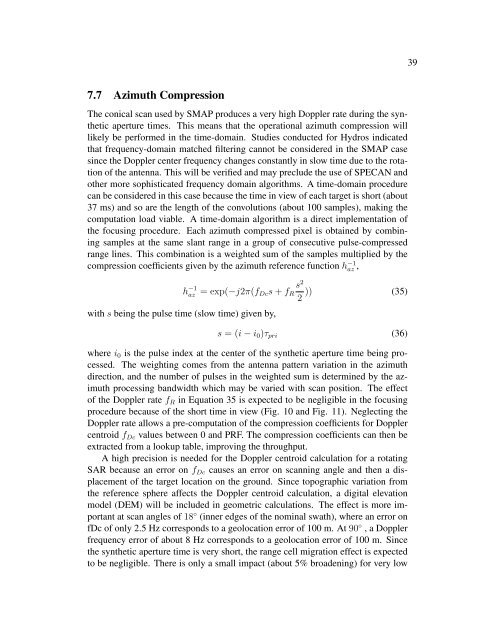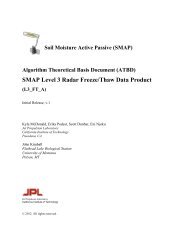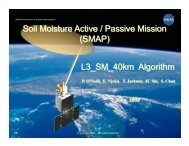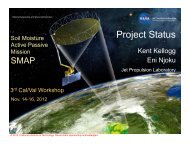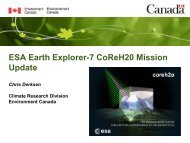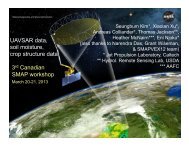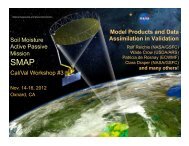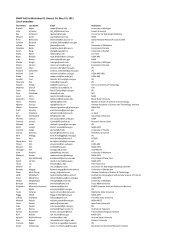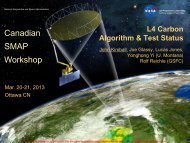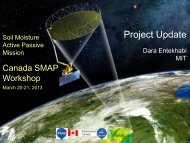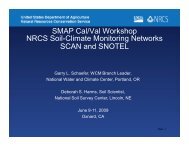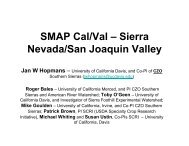(ATBD) SMAP Level 1 Radar Data Products - NASA
(ATBD) SMAP Level 1 Radar Data Products - NASA
(ATBD) SMAP Level 1 Radar Data Products - NASA
You also want an ePaper? Increase the reach of your titles
YUMPU automatically turns print PDFs into web optimized ePapers that Google loves.
39<br />
7.7 Azimuth Compression<br />
The conical scan used by <strong>SMAP</strong> produces a very high Doppler rate during the synthetic<br />
aperture times. This means that the operational azimuth compression will<br />
likely be performed in the time-domain. Studies conducted for Hydros indicated<br />
that frequency-domain matched filtering cannot be considered in the <strong>SMAP</strong> case<br />
since the Doppler center frequency changes constantly in slow time due to the rotation<br />
of the antenna. This will be verified and may preclude the use of SPECAN and<br />
other more sophisticated frequency domain algorithms. A time-domain procedure<br />
can be considered in this case because the time in view of each target is short (about<br />
37 ms) and so are the length of the convolutions (about 100 samples), making the<br />
computation load viable. A time-domain algorithm is a direct implementation of<br />
the focusing procedure. Each azimuth compressed pixel is obtained by combining<br />
samples at the same slant range in a group of consecutive pulse-compressed<br />
range lines. This combination is a weighted sum of the samples multiplied by the<br />
compression coefficients given by the azimuth reference function h −1<br />
az ,<br />
h −1<br />
with s being the pulse time (slow time) given by,<br />
s 2<br />
az = exp(−j2π(f Dc s + f R )) (35)<br />
2<br />
s = (i − i 0 )τ pri (36)<br />
where i 0 is the pulse index at the center of the synthetic aperture time being processed.<br />
The weighting comes from the antenna pattern variation in the azimuth<br />
direction, and the number of pulses in the weighted sum is determined by the azimuth<br />
processing bandwidth which may be varied with scan position. The effect<br />
of the Doppler rate f R in Equation 35 is expected to be negligible in the focusing<br />
procedure because of the short time in view (Fig. 10 and Fig. 11). Neglecting the<br />
Doppler rate allows a pre-computation of the compression coefficients for Doppler<br />
centroid f Dc values between 0 and PRF. The compression coefficients can then be<br />
extracted from a lookup table, improving the throughput.<br />
A high precision is needed for the Doppler centroid calculation for a rotating<br />
SAR because an error on f Dc causes an error on scanning angle and then a displacement<br />
of the target location on the ground. Since topographic variation from<br />
the reference sphere affects the Doppler centroid calculation, a digital elevation<br />
model (DEM) will be included in geometric calculations. The effect is more important<br />
at scan angles of 18 ◦ (inner edges of the nominal swath), where an error on<br />
fDc of only 2.5 Hz corresponds to a geolocation error of 100 m. At 90 ◦ , a Doppler<br />
frequency error of about 8 Hz corresponds to a geolocation error of 100 m. Since<br />
the synthetic aperture time is very short, the range cell migration effect is expected<br />
to be negligible. There is only a small impact (about 5% broadening) for very low


